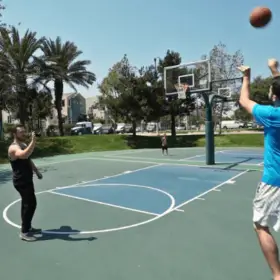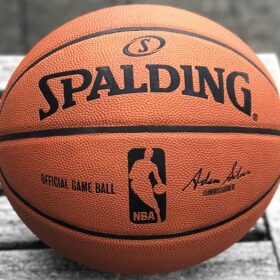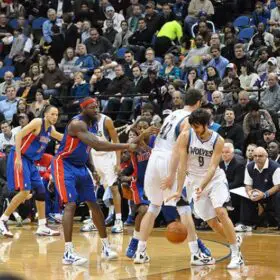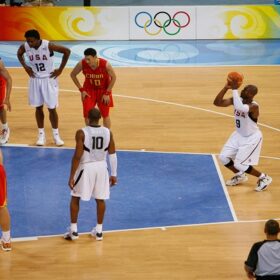Have you seen how basketball players dribble and pass the ball in like no time altogether? Their swift movements are hard to keep track of, and just in a fraction of second, the ball is in someone else’s hand. It is like the ball barely stays in hands and just swirls around in the air. It’s all because of the basketball 5-second rule.
This rule explicitly states that an offense player, who is closely guarded, cannot just hold the ball or keep stalling. He has to either pass it to another player or shoot it towards the hoop. The violation of this rule favors the opposite team.
There are two different versions of the offensive 5-second rule’s violation and then consequently, its penalty. NCAA and Youth League utilize one of the variations, and the NBA employs the other. However, both aim to minimize the time for which the offensive player gets to keep hold of the ball.
Though the defense can work their defense strategy only at an arm’s length distance from the ball-handler, the basketball 5-second rule really restricts the gameplay of the ball-handler. However, the 5-second count restarts whenever the ball handler changes his move.
It is imperative for defenders to fully comprehend this rule because if the basketball 5-second rule is implemented at the right time, it can flip the scores of the game.
What Is The 5-Second Rule In Basketball?
Basically, this rule is a violation of basketball rules. If the offense player receives the ball and the defense players guard him, he will have a total of 5 seconds to either dribble the ball, keep on holding it or pass it. In the end, this rule appraises the wit and reflexes of the ball-handler. He must devise a strategy in his mind and execute it optimally, all in less than 5 seconds.
In these 5 seconds, he can also dribble the ball and then hold it (which will be regarded as a change in his move) or vice versa.
Many youth Basketball leagues have constituted their own rule books, which are different editions of the official NBA rule book but with slight variations. So, to draw a fair comparison, we will take the NCAA rue book for reference.
You might notice that the basketball 5-seconds rule is termed as “closely guarded” in the rules as the timer for 5 seconds begin when the ball-handler is guarded. The term closely guarded is only applicable if the defender is within six feet of the ball-handler.
Different distinguished tournaments like Olympics also implement this rule of Closely Guarding.
What Is The Penalty Of The 5-Seconds Violation?
If the ball-handler of the offense team violates this rule and fails to change his move under five seconds, then the ball is given to the opposing team. The penalty results in a change of possession of the ball. Though it is not a serious violation, so it won’t be counted as a player’s personal foul, and it won’t be added in the team’s bonus count.
The Official NCAA’s Closely Guarded Rule
If you carefully examine the rule book of NCAA, you will find a section pertaining to the rule and its violation, rule 9, section 14, to be exact. These rules explicitly state that the count will restart if a defender is consistently guarding the ball-handler and the ball-handler’s movement. If another player intrudes between the defender and the ball handler, the count is halted.
Penalty In NCAA
The official NCAA rule book states that:
“The ball shall become dead or remain dead when a violation occurs. … The opponent will get the ball for a throw-in.”
Hand Signal To Indicate Violations Of Basketball 5-Second Rule
To declare that the basketball 5-second rule has been violated, the referee first immediately blows the whistle, and it will show number five with his hand to the audience demanding change in possession of the ball.
But to show the count, the referee first clearly indicates that the count has begun, and if the ball-handler changes his move, the referee asks for a count restart by switching his arms.
What Is The 5 Second Rule In The NBA?
The official NBA rule book refers to this violation as the Five-Second Back-to-the-Basket Violation. This violation occurs when the ball-handler turns his back to the defender and the basket and then posts-up; he takes advantage of a shorter or smaller defender and positions in the area that is below the foul line but near the basket.
NBA’s 5-second rule is only applicable when the player is posting up.
Penalty In NBA
The penalty for violating the basketball 5-second rule in NBA is
“Loss of ball. The ball is awarded to the opposing team out-of-bounds on the nearest sideline at the free-throw line extended.”
This penalty immunes the player’s personal count or the team’s bonus count to bear the charge.
Hand Signal To Indicate A Violation Of Basketball 5-Second Rule
The referee first indicates that the count has begun. The referee usually stands under the basket so all players can view the count. If the count reaches 5, the referee blows the whistle and halts the play. Then the opposite team will take the ball.
History Of The 5-second rule In Basketball
The NBA constituted this rule in 1999 because of the gameplay of the legendary forward, Charles Barkley. His signature move would be to turn his back on the defender and basket and then move to an ideal position from where it was easier to score. As this move garnered a lot of attention and everyone began to repeat it, the NBA regarded it as a serious violation.
Conclusion
The basketball 5-second rule is a very crucial violation that can completely turn the dynamics of the game. Once the opposite gets the possession of the ball because of your doing or slight negligence, the tables can turn, and you could lose the match. As the ball-handler keeps the count in mind and as the defender, don’t let the ball-handler change his move! May the quick-witted player win!






